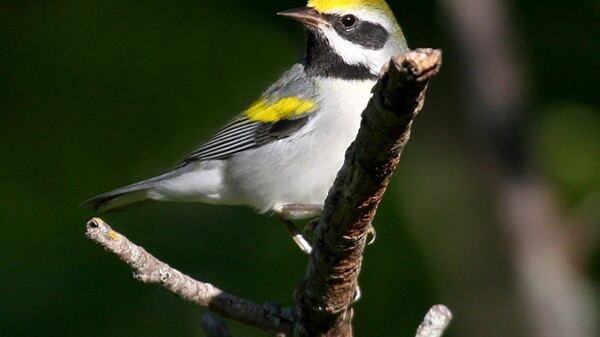The Birds Are Back in Town
citywide count of feathered fliers planned for May 14

Among the streets and houses, in a quiet neighborhood, on a warm spring day, under the clear cobalt sky, something moves in the trees above, a restlessness between the leaves. If you stop and look up, you see a throng of color flutter from branch to branch. A faint chorus of peeps and chirps emanates from the trees.
Looking closer, you see a flurry of little birds. These are not the same birds you see at your backyard feeder; they are not robins, crows, or cardinals. These birds look like they’ve been dipped in paint: one has a flame-orange body punctuated with jet-black streaking, another has bright gold wings contrasted with a cool slate-gray body. These birds look like they belong in the tropics.
These little creatures have pushed their way across two continents to be here, in your neighborhood, in your town. They have flown non-stop across the Gulf of Mexico. They have dodged predators, braved thunderstorms, and flown into headwinds.
Next you notice is that these birds are very busy. They are darting through the foliage, probing the leaves, snapping up caterpillars with their beaks. They dive from branches, scoop up gnats from mid-air, and return back to their perches. At first, this scene may seem entirely unremarkable: just some birds in a tree.
But here’s the thing: These little creatures have pushed their way across two continents to be here, in your neighborhood, in your town. They have flown non-stop across the Gulf of Mexico. They have dodged predators, braved thunderstorms, and flown into headwinds. They weigh little more than a nickel, yet they have come all this way.
It happens every spring. Hundreds of thousands of birds pour out of the tropics and head north for the summer to build nests and raise families. They fly at night when temperatures are cool and the air is stable. They navigate by the stars and electromagnetic fields. As the eastern sky shows a first hint of light, they drop back down to land and look for a good place to load up on caterpillars. That place could be anywhere: a local park, a wildlife area, a neighborhood, or a college campus.
On Wednesday, May 14, at the peak of spring migration, Eau Claire will hold its first ever Welcome Back Bird Day, a citywide celebration of birds. Birders and biologists will be stationed at five locations around the city, armed with binoculars and clipboards. They will count as many bird species as they can find, and while doing so they will share their knowledge with anyone and everyone who happens to stop by.
The event will be a great opportunity for people to enter into the world of migratory birds. For some folks, it might be their first chance to see a magnolia warbler or a scarlet tanager. With the help of an experienced birder, people can learn how to easily identify birds without the stress of fumbling through the pages of a field guidebook. Once a bird has been identified, folks can learn even more about its biology, habitat, songs, and conservation.
Welcome Back Bird Day will begin early in the morning and continue on until evening, from 8am to 8pm. Stations will be at Braun’s Bay, Owen Park, Little Niagara, Truax Prairie, and Dell’s Pond. You can stop by a station for a few minutes or a few hours, or visit multiple stations, many of which feature different habitats and are within easy biking distance of one another. Stations will send text messages back and forth throughout the day as more species are counted. The goal is to identify more than 100 species across the city.
So, there you are, standing under a tree, looking up at a flock of colorful birds. You wonder: Where did they come from? Where they are going? What are their names? On May 14, at the Welcome Back Bird Day, you can have those questions answered as you get up close and personal with the birds. Come enjoy the migration alongside people who know and care about birds.
Hogseth is a wildlife biologist with the state Department of Natural Resources, which is sponsoring the event along with Bird City Wisconsin and the Gaylord Nelson Audubon Society. For more details about Welcome Back Bird Day, go to gaylordnelsonaudubon.org.
Find A Bird Day location!
Visit one of the "Welcome Back Bird Day" locations to enjoy the spectacle of spring migration in the Chippewa Valley. Birders will be there with scopes, binoculars, guides and help to locate and identify birds.




















